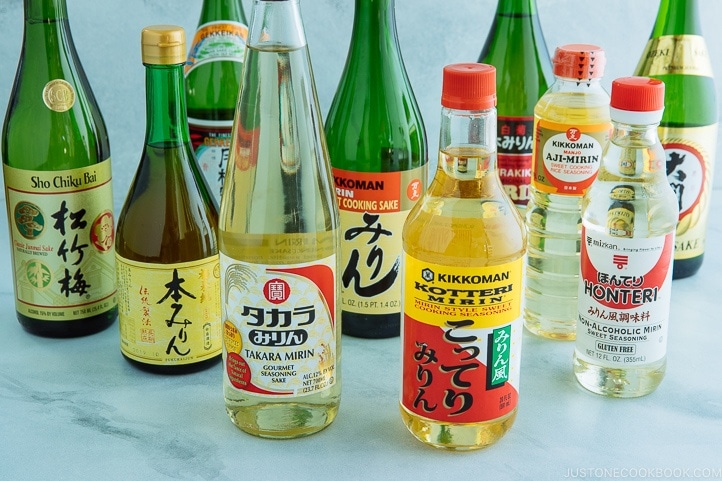The rice wine mirin gives Japanese cuisine an incredible taste. It is also an excellent counterbalance to the salty taste of soy sauce and other traditional Japanese dishes due to its high sugar. Furthermore, according to its sugary consistency, it is indeed a vital element in Japanese glazes like teriyaki sauce.
Like saké, Mirin has a high level of sugar as well as about 15% alcohol by quantity. You like to know that sake is a substitute for Mirin. Processed glutinous rice, farmed rice (known as koji), and condensed rice liquor are all useful to produce proper Mirin, also recognized as “hon-mirin.” Around two months and several years are given to this mixture to ferment. This method of making Mirin gives it a deep, nuanced flavor with much umami.

Table of Contents
Difference Between Sake and Mirin
Sake is maybe the first Japanese rice wine that comes to mind. Mirin is somewhat identical, although there are some significant differences.
Furthermore, Mirin is typically something less alcoholic than typical sake. That promotes greater adaptability and simplicity of application in cooking.
According to the production of distinct complex carbs during alcoholic fermentation, Mirin also has a significant sugar concentration. Without even any extra sugars, this turns ordinary Mirin richer.
All these Mirin and sake are being used in Japanese cooking and other cuisines; however, the same manner both are mixed can vary.
Sake is frequently introduced a bit earlier in food preparation because of its more substantial level of alcohol, which gives the alcohol very little time to evaporate. Sake is an appropriate substitute for Mirin. Yet, Mirin does not need much more in the means of increased preparation or modification before it could be used in a recipe, making it significantly beneficial when preparing sauces and glazes.
Some Substitutes for Mirin
Sake
As it’s already a rice wine, it brings you halfway there as a mirin replacement. Several types of sake, particularly unprocessed types, are strong enough to substitute Mirin organically. A splash of freshly squeezed apple or white juice and a teaspoon of sweetener can replace sake drier than usual.
Sherry
Sherry has a subtle, complex taste that can approximate white wine’s richness and acidity. Sherry appears to be on the mild side. Since it already has a strong, sharp flavor, add it by the tablespoon until you get the optimum amount of richness.

Rice Vinegar
Rice wine and rice vinegar each have a solid fermented aroma. With white wine, rice vinegar’s acidity can be subdued with sweetener, a splash of light-colored liquid, or the sugar rice vinegar available in the food section of your supermarket.
White Wine
Most white wines could also be used to substitute for Mirin, although it’s usually better to avoid very syrupy ones, such as Moscato or cold wine. Just use some sugar mixed in a moderately dry white wine before serving it to the meal to approximate the sweet Mirin might add.
Vermouth
When searching for a substitute for Mirin, you could observe that you’ll explore the wine cellar more frequently than the supermarket. The same principle also applies here: To guarantee the acid is controlled, use sweet vermouth or add extra juice or sweetness to dry vermouth.
Mirin Varieties
In general, there have been four distinct types of “mirin.” Although some specifically demonstrate that they have been a similar version of Mirin which will work for even the majority, others have been considered as just being faithful to the original.
High on the ranking is hon mirin, also referred to as real Mirin, which has shochu, a fine liquor that some equate to vodka and measures 14 percent alcohol content. With just that amount of alcohol, hon mirin might last three months outside your refrigerator.
Below is what is constantly referred to as “plain ol’ mirin,” which generally replaces that shochu with the more well-known sake.
There are already two strongly linked mirin substitutes, including one with specific alcohol by volume. There is indeed a “mirin-type condiment,” also termed aji mirin. The particular type typically consists of a mixture of starch syrup, rice, & salt in combination with 10 to 13 percent alcohol content.
There are indeed “mirin-like condiments,” also. The primary distinction is the relatively complete lack of alcohol, with goods in this category having an Alcohol by volume of between 1% and 0%.

Mirin’s Uses
Mirin is commonly used in Japanese cuisine to produce a dish with a delicate, gentle taste and brightness. Mirin will help the dish become sweeter and much more unique as Japanese people seem to enjoy sweet flavors, yet their richness originates from natural sweetness instead of sweetness from sugar.
The compelling odor control characteristics of Mirin are a popular choice for salty meals like meat and vegetables. Moreover, it catalyzes to enhance the taste of several meals by helping them integrate spices even more thoroughly.
Mirin also keeps the flavors of such items from dissolving while they are cooked by supporting the components in adequately absorbing the spices. Furthermore, Mirin improves the luster and elegance of steamed, roasted, and stewed meats.
Consequently, when cooking, the Japanese apply Teriyaki, Teriyaki, and Mirin in stewed dishes. For something like the stock, Mirin would be first used, and afterward, flavors like salt, sugar, and soy sauce are started adding to produce a beautiful, attractive texture.
Next, add Mirin while presenting the ready meals. Before mixing the ingredients, they will stew all the spices, notably Mirin, with the braised seafood. When it comes to Teriyaki, the dinner will first be cooked quickly at high temperatures after being broiled until it becomes brown.
Final Words
In particular, Mirin is a substance used throughout the production of sauces such as soy sauce, teriyaki sauce, etc. There seems to be little doubt that Mirin is used to make the Teriyaki sauce, also typically found in Japanese eateries. That’s also why every kind of sauce has a unique taste and a Japanese-inspired presentation.
Even though the Japanese apply Mirin as a flavor to increase the food’s sweet taste, they use only a small amount—not far too much, even as Mirin’s flavor is incredibly potent and will overpower other items’ flavor enhancers.










![Is Tokyo Ghoul on Netflix? [How to Watch Online]](https://avctv.com/wp-content/uploads/2022/08/AAAABct1DaUzhEt4JeJFeDrmaE_4CGAu39fBN6poMx10hAlWlMRjkkAw84hjmuujWTy2wFC7_Pjnujec-_PqT1GCnnMFMJ15S04baJn1b0WvvbG6hrSNb31_GS4--120x86.jpg)





